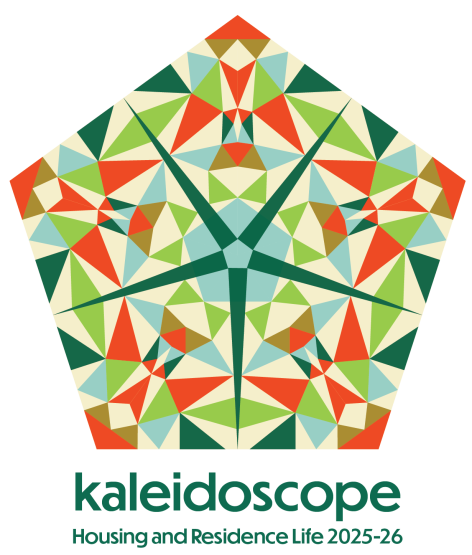
History of Goals and Themes
The use of "themes" was a longstanding tradition for the Department of Residence Life and continues to be central to the continuing work of the Department of Residential Housing. The purpose for annual themes is to have an annual focus that would relate to the goals of the department and serve as a symbolic reminder of the purpose of our work. As an added element, staff are given a small gift relating to the theme that serves to further remind staff of their important role in the department. The power of the theme has grown throughout time. There is also a tradition of keeping the theme a "secret" until Orientation begins, which helps to keep staff excited and interested in beginning their year. One remarkable aspect of the themes is that staff really do take an interest and have a personal investment in supporting the theme and its relation to the goals. What follows is a brief synopsis of the past themes.
2025: Kaleidoscope

Sometimes, just like with a real kaleidoscope, you have to turn the lens or shift the angle to see the full picture. It takes movement and reflection. The image is never fixed-it’s constantly changing, growing more vibrant as new pieces fall into place. This theme reminds us that growth, understanding, and creativity often come through change and collaboration. It celebrates how we each contribute to something larger, more dynamic, and more beautiful together.
2024: Compose
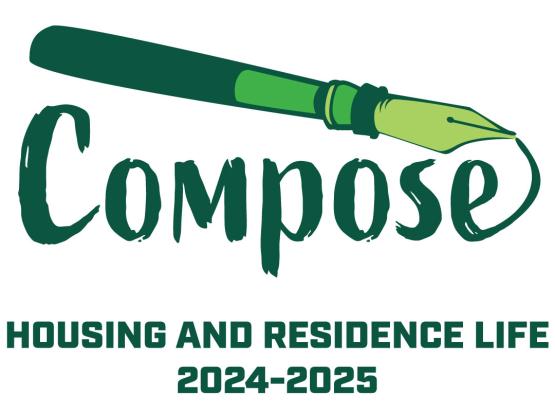
2023: Moxie
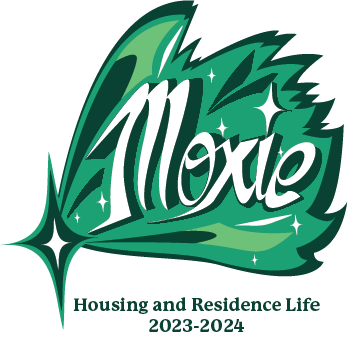
Welcome to our department's 2023-24 theme: MOXIE! But what exactly is moxie? It’s that spark of courage and determination that defines a person's resolve in the face of challenges. It’s about having the grit, the spunk, and the tenacity to push forward when others might hesitate. Moxie isn’t something you can simply learn from a textbook or acquire through formal education. It’s a spirit that has been celebrated throughout history. It’s that boldness and fearlessness in the pursuit of what’s right.
So, who has moxie? It’s anyone who embodies a unique blend of courage and resilience. It’s in the actions of those who refuse to back down from difficult situations and who inspire others with their unwavering determination. When you hear the word “moxie,” you might instinctively understand its essence. It’s about making the most of life’s opportunities and challenges, about taking your life to new heights and depths.
At our department, moxie isn’t just a word; it’s a call to action. It’s about bringing your spirit, savvy, and courage to everything you do—for our residents, for each other, and for ourselves. It’s about recognizing and celebrating the incredible strength and determination that each of you brings to our team. So, let’s embody that fearless spirit that moves mountains and creates positive change. Because with moxie, there’s no limit to what we can achieve. Together, we’ve got moxie.
2022: Evolve
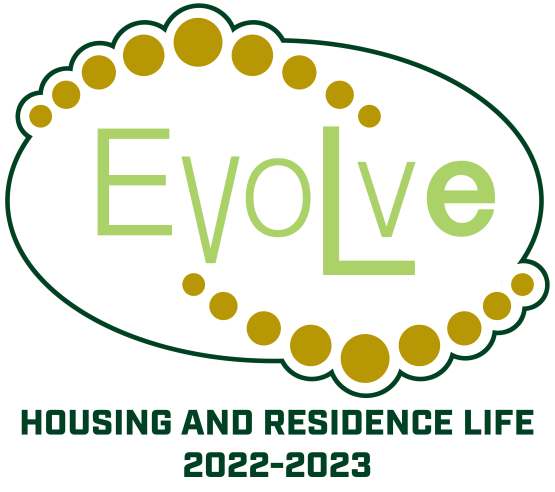
This word resonated with the department as we are forever evolving, in a state of flux and change. We are in process of seeing where we’ve been, where we are and where we want/need to go. This is inclusive of our work and of our staff. There is something active about the word – which the definition and quotes below seem to articulate. There is a growing, changing, developing – an engagement & investment in the process. It seems to capture where we’ve been, where we are and where we want/hope to go.
Definition: To develop gradually, especially from a simple to a more complex form.
"You have to be involved to evolve." -Glen Plake
"Optimism is the most important human trait, because it allows us to evolve our ideas, to improve our situation, and to hope for a better tomorrow." -Seth Godin
"Life is about evolving. Don’t stay in a situation that’s not helping you grow mentally, spiritually, and emotionally." -unknown
"You are presented with two choices: evolve or repeat." - unknown
"I want to grow. I want to be better. You grow. We all grow. We’re made to grow. You either evolve or you disappear." -Tupac Shakur
"What’s dangerous is not to evolve." unknown
"To sustain longevity, you have to evolve." Aries Spears
"The whole point of being alive is to evolve into the complete person you were intended to be." -Oprah Winfrey
"Continue to grow and evolve." -Mahatma Gandhi
"Awakening is dynamic, constantly evolving in accordance with life’s realities." -Taitetsu Unno
"Being a fish out of water is tough, but that’s how you evolve." -Kumail Nanjiani
"Change and growth is so painful. But it’s so necessary for us to evolve." -Sarah McLachlan
2021: Re-Imagine
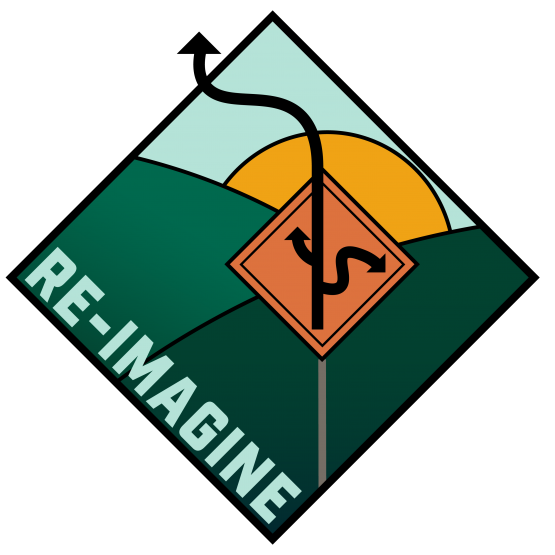
Amazingly, this is the 35th anniversary of our department having an annual theme. The theme was and is meant to be a symbolic reminder and icon of the purpose of our work and effort for the upcoming year. 2016 saw “Traditions” as our 30th anniversary Theme. Following “Traditions” was “Stories” and “Discovery.” 2019 our theme was “Courage” which resonated with many and led us into the beginning of the pandemic. 2020’s theme – “Resilience” – found us navigating uncertainty, constant change, and the ever-present PIVOT! It was a year that called for being able to come back from difficulty, to persevere, and to grow again.
Johann Wolfgang von Goethe wrote, “Everything has been thought before. But the difficulty is to think of it again.”
This year we are coming back to familiar territory – while at the same time knowing so much has changed and may continue to change. There is excitement and hopefulness, as well as caution and a trepidation.
Finding and settling on a work this year was hard. How to think outside the box? What is the purpose? What direction to take? How to capture the idea in a design?
Candy Change said – “No one said you can’t go outside the lines.”
The work this year may look a little familiar. There is a history and background there. But like the upcoming year – we are taking something that may be familiar and looking at it differently, looking through a different lens, thinking about what could and can be rather than in addition to what has been.
Our theme this year is “Re-Imagine”
Susan C. Young said: “Re-imagination is the birthplace for vision and change. Your imagination is one of the most valuable talents you have and deserves your full attention. Imagining how you want to live your life is one thing but connecting your imagination to a visual representation will give you exactly the traction you need to make it a reality.”
We will be re-imagining what this experience is and what the year can be. There are and will be many similarities to what has been, but we need to re-imagine how it can be. May of us have not had a “real” campus experience – haven’t seen what it means to be a staff member “in-person.” Our residents will be in the same place. They have an idea of what coming here, or coming back here, means – what they are hoping for – but we may have to help them re-imagine what that looks like.
Deepak Chopra said – “I remember the past, and I learn from it. I rejoice and celebrate in the present, and I re-imagine the future. Now is the moment that never ends.”
We ask you to join us on this journey – to Re-Imagine who we are, what we do, where we are going, and how we will get there.
2020: Resilience
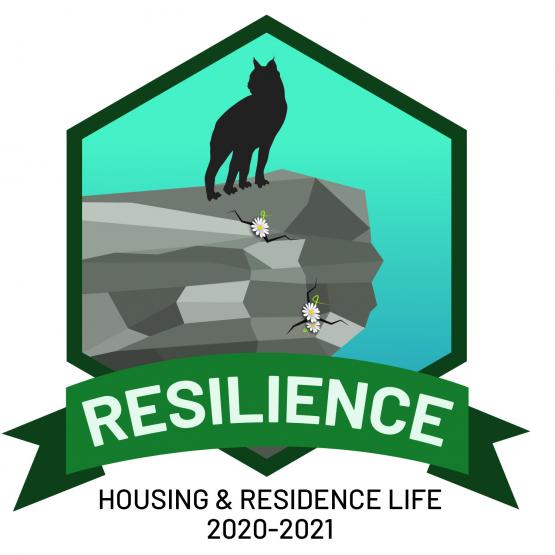
A Theme is something one can rally around, can find purpose or direction in, and can help guide or direct one’s efforts. Each year we have a Theme that tries to capture the nature of our work and what we hope to achieve.
The last five months have been a roller coaster ride of hills and valleys, sharp turns, and unexpected twists. Have you ever heard the term “Plot Twist?!” Welcome to 2020.
A Theme had been chosen in February. But with our unexpected plot twist – we found that the landscape was quickly changing – so the Theme needed to change as well.
Last year, our theme was Courage. It was tempting to continue with that theme given what was happening in our world. But we found something that picks up from Courage and helps lead us into this next phase of navigating what our year together will be.
There are so many things – living and navigating a pandemic and COVID, the continuing struggle against racism, the resurgence and importance of Black Lives Matter, Virtual Learning, lives, traditions and celebrations being interrupted, new traditions and connections being made, amazing acts of kindness, phased openings, face masks, washing your hands, In Person and Virtual RAs – and there are sure to be more.
Eleanor Roosevelt said – “With the new day comes new strength and new thoughts.”
Our Theme this year is – Resilience
The definition of Resilience is – the ability to recover from or adjust to misfortune or change.
We are in the process of adjusting and finding ways to recover. We are finding our strengths and honing skills to deal with. Learn about and grow from what we, and our residents, are experiencing.
“Resilience is the capacity of a system, enterprise or person to maintain its core purpose and integrity in the face of dramatically changed circumstances.” ~Andrew Zolli
If you look at our logo – we see a bobcat on a cliff that appears barren and bleak. But you also see flowers, daisies, growing out of a crack in the rock – finding a way, reaching for the sun, still there and making it through, somehow. This is not easy or without challenges, but it is promising. It is hopeful.
This year we hope and will create communities and experiences in new and different ways – to give hope, and to establish connections.
We are so excited that you are joining us. We will exemplify Resilience.
2019: Courage
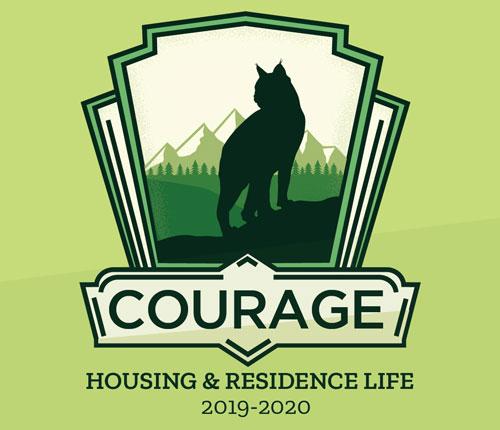
There are challenges in this world - visible, not visible, felt by few, felt by all. It is, or can be, a challenge to find one's voice, to find one's strength, to help strengthen others, to be the only, to make a connection, to try new things, to do things differently, to make mistakes, to stand out, to try, to fail, to be heard, to intervene, to be a student, to express one's concerns, to not be "the norm", to be a staff member, to be seen, to care about others, to care about oneself. These challenges can come with great hurt, confusion, history, joy, anger, reward or renewal. There is strength, or the potential for strength, in this year's theme, as well as vulnerability. This year's theme acknowledges heart. This theme may help one to break the patterns in one's life that no longer serve them. This theme might help one to continue to try again another day. This year's theme is... COURAGE.
2018: Discovery
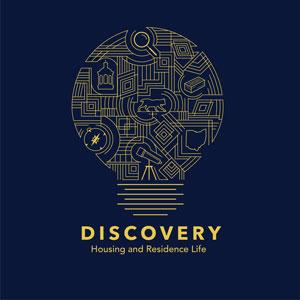
“There is no discovery without risk and what you risk reveals what you value.”~Jeanette Winterson
Discovery is finding and/or uncovering something – possibly for the first time. This can also lead to the of rediscovering something. Discovery can help one uncover and become aware of strengths and courage they did not know they had. One can discover the value and importance of things that are different from them – which and uncover something special – maybe a treasure.
“Mistakes are the portals of discovery.”~James Joyce
Discovery can be the uncovering of something unexpected – and maybe not always positive - but the act of discovery allows for change.
The real voyage of discovery consists not in seeking new landscapes, but in having new eyes.~Marcel Proust
This year, try new or different approaches. See with different lenses. Learn from missteps and keep trying. Be open to the journey and what you – we – can learn along the way. Join us in this year of DISCOVERY.
goals. What follows is a brief synopsis of some past themes.
2017: STORIES
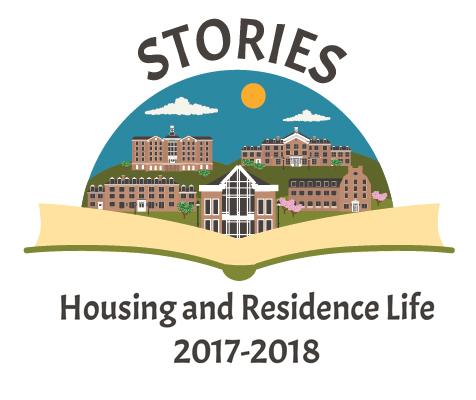
“Stories make us more alive, more human, more courageous, more loving.” ― Madeleine L'Engle
The importance of one’s story is immense. It helps to show ones’ roots, influences, joys and challenges. It helps to define, and maybe, redefine who one is. But knowing one’s own story is a singular experience. Hearing, knowing and understanding the story of others is eye opening, heartbreaking, empowering, challenging, and amazing. It allows us to broaden our awareness of the experiences and feelings of others, even though it is not our reality. Truly listening to these stories can take us to places we have never seen and introduce us to those around us. In our work, it is so important to listen to and share the stories around us – and to encourage and challenge others to do the same. Knowing the story of others can help bridge gaps, mend misunderstandings, and create opportunity for deeper relationships. Our communities are stronger when we share our stories and accept the stories of others. Stories. A simple word, but one with depth and nuance. We ask you to join us in this effort. This is where our story begins.
2016: TRADITION
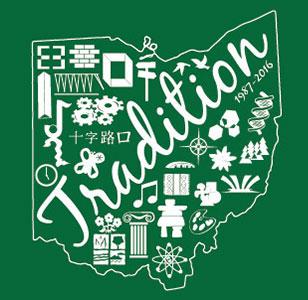
The use of "themes" is a longstanding TRADITION for the Department of Housing and Life. The original purpose for annual themes was to have an annual focus that would relate to the goals of the department and serve as a symbolic reminder of the purpose of our work. The Department of Housing and Residence is thrilled to be celebrating the 30th Anniversary of using themes this year. In part to recognize this milestone, TRADITION is the theme for 2016-17. TRADITION is the transmission of customs or beliefs from generation to generation. Our traditions help connect us as members of a community. Traditions connect us with the current members of the community and extend those community connections over time, both into the past and forward into the future. As housing and residence life staff, you share commonalities with those staff from theme years of “Foundations” right up through “Catalyst”. We are building on the work of those who came before and laying a path for those who will come after us. Like those staff member of 30 years ago, we are here to help students learn and grow. Some of the challenges are similar but have taken new forms. Other challenges our predecessors could not have imagined. Let us continue in the work of our staff community, carrying on the traditions that positively serve students and establishing new traditions to meet the times. With over 200 years of Ohio University TRADITIONS and 30 years of theme TRADITIONS we thought this would be the perfect theme. TRADITIONS play such an important role in the college experience and so many memories of college are based on TRADITIONS that student and staff experienced. We will learn about and celebrate past and current TRADITIONS and themes while also creating and developing new TRADITIONS for our staff and residents.
2015: CATALYST
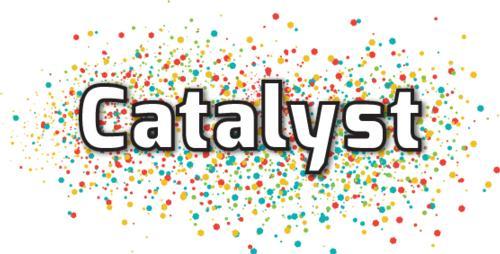
A catalyst is "a person or event that quickly causes change or action.” In our work, the theme, “catalyst” reminds us that we have the ability to change lives and to guide students' actions in positive ways. We can think of a catalyst as a person whose attitude, communication, or actions help others make positive moves in their own lives or in the lives of others. We seek to inspire students to be catalysts as we ourselves are catalysts for them. Reaching out, helping others, building bridges, challenging thinking, and encouraging commitment are great ways to serve as catalysts.
At times we act as catalysts in the lives of others without even realizing the extent to which we have done so. Picking up a piece of trash on campus, paying someone a compliment, and encouraging a student’s leadership potential are just a few exemplary forms of catalytic contributions. As a specific means of bringing our departmental theme to life this year, we encourage our 350 plus staff members to work collectively toward achieving 350,000 acts of good will throughout the academic year. The power behind this ambitious goal of 350,000 catalytic contributions rests in our ability to encourage others to pay it forward. Our impact is magnified exponentially when we take a step beyond our own good deeds by inspiring others to initiate good deeds of their own.
In what great ways will you serve as a catalyst in our community this year?
2014: IMPACT
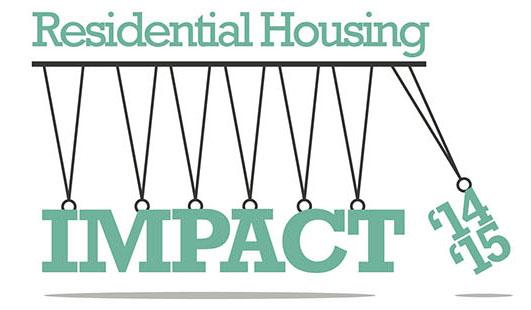
IMPACT: In every day, there are 1,440 minutes. That means we have 1,440 daily opportunities to make a positive impact.
-Les Brown
Think about it: a Resident Assistant is perhaps one of the important people that students interact with at Ohio University. Starting with smiles and helping hands at move-in, RAs play a crucial role in their student's lives. RAs are the heartbeat of the department, striving to connect to residents, serve as a resource, encourage and inspire their residents, and most of all, IMPACT the experiences of their fellow Bobcats.
Let's be honest, the RA position is not always glamorous. But beyond the sleepy eyes and cups of coffee, the tears with residents and stress with deadlines, the tireless work of bulletin boards and programming supplies, is a person that has the power to make an IMPACT on their residents.
2013: REACH
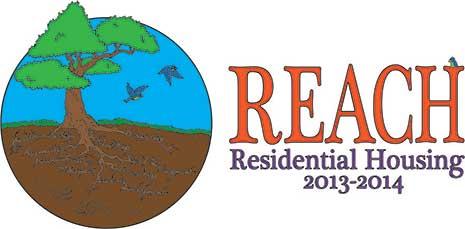
Reach: a multifaceted bit of vocabulary illustrated by an emblem of tree, earth, sky and a small selection of animalia. Within the logos snapshot of biosphere resides a most poignant example of patience, endurance, achievement, an encompassing stretch of experience, reciprocity, and of course, health and goodness.
When reaching, we must remember that as we strive towards our goals and desires, or toward one another, we should also strive profoundly in other directions to establish our own health and foundations - looking to our cultures, homes, experiences and enlightenments which have made us an amazingly diverse population.
As a 21st century people, we consistently long to move forward, to reach new and wonderful destinations, to be progressive as well as optimistic en route. The Department of Residential Housing shares this drive while also hoping to reach into the values that have kept us rooted as an exemplary body of support for students as they attempt to find a home on their very own specific piece of OHIO earth.
2012: INUKSHUK
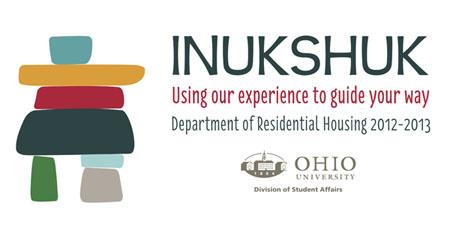
Inukshuk is an Inuit word referring to human-made stone landmarks. While many cultures around the world have similar traditions, the Inukshuk originated in the arctic regions of North America. These stone pilings are often built to resemble the shape of a person and they are meant to stand out in an environment that has few natural landmarks.
Imagine traveling across a wide open expanse of tundra. There might be no roads, no buildings, no trees, no hills, or even obvious trails. It would be very easy to lose your way. Add in less than ideal weather and it's not hard to imagine quickly becoming disoriented even in an otherwise familiar area.
But finding an Inukshuk would let you know that you’re not completely lost. It would tell you that you found food, or water, or perhaps the way home. The fact that an Inukshuk is shaped in a way that would not have occurred by accident tells you that someone has been here before you. It tells you that someone cared enough about those who would come later to provide them with a symbol of safety and comfort.
The landscape of college can, at times, feel just as disorienting and desolate as the Tundra to a student whose life may seem to be in a state of perpetual transition. Our students need to know that they are not lost. They need to know that others have walked this same path and walked it successfully. They need to know that someone who already knows the way cares enough about their success to mark the way for them.
Because we know the path to success, because we know the dangers to avoid along the way, and because we care about those who come after us, we as Residential Housing, are in the ideal position to be the Inukshuk that will guide our students' way.
2011: LEGACY
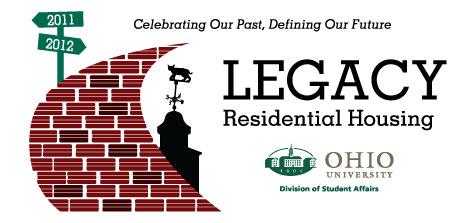
2011 marked the 25th year of themes within our department. We began with “Foundations” in 1987, which was represented by a clay brick (see above). So it’s fitting that in 2011 we wove the brick into our theme of “Legacy– Celebrating Our Past, Defining Our Future.” This theme reflected a sense of time – past, present and future – and the impact that our life and work has on individuals and the legacy of Ohio University.
How might you view a legacy?
First, we help students discover their legacy. As leaders, we have an impact on students’ growth and success whether through a quiet one-on-one conversation or a large-scale initiative. Through a blend of challenge and support, we help students achieve.
Secondly, we think about the mark we are leaving within our department and elsewhere on campus. Our contributions, our willingness to challenge our department to grow, and our interactions with students and fellow staff members all define the legacy we are weaving.
Thirdly, there is legacy through leadership. What are the effects of our leadership? The Iroquois Nation fosters a principle of remembering the 7th generation to come when making decisions. Thinking of the far-reaching impact of all our decisions helps us act ethically and responsibly. As we walk the brick-lined paths of campus, we take a moment to imagine how we will create our legacy and help others to do the same.
2010: ARETE

Arete is a concept articulated by the Ancient Greeks. It can be translated as “virtue” or as “excellence.” It is the value of attempting to be the best that one can be, or to fulfill one’s potential. However, the 21st Century, American expression of these ideas seems to fall short of their original meaning.
The Greeks, in the times of Plato and Aristotle believed that for each object there was an ideal and perfect expression of the object which was tied to fulfillment of its purpose. A knife, for example approached perfection by being sharp, by being strong, and by feeling balanced in the user’s hand because all of these characteristics made the knife more efficient at cutting. However, for another tool, with another purpose, these characteristics might not necessarily be virtues.
Arete applies the same way to people. A person approaches excellence not simply by being “the best”—the strongest, the smartest, the richest. A person’s path to excellence and virtue is defined by purpose, and by a focus on fulfilling that purpose. So for us, as a Residential Housing staff, excellence can be defined by a higher effort toward fulfilling our values and goals. By embracing Arete as our theme, we did not merely ask ourselves to perform at a higher level, we are asked ourselves to more deeply understand why we do what we do—to more carefully consider the value of our Values. The difference between Arete and mere “excellence” is like the difference between speed and a vector. A vector is defined by velocity and direction. Arete, for Residential Housing, lied not just in what we do, but why we do it. Arete was in creating the communities in our residence halls that allowed our residents to discover their purpose and to fulfill the promise of their potential.
2009: FUSION

Fusion, the 2009-10 theme for Residential Housing, was a literal and figurative choice for our department at the time. In January of 2009, the Department of Residence Life and the Housing Office merged into one department resulting in two areas fusing their visions, missions and goals into one. This literal fusion of the departments had one primary goal in mind – to bring separate yet related elements together in order to provide effective service and education to our students. As this academic year began, we desired to actively demonstrate our merge through the choice of the theme Fusion – Bringing it All Together. Fusion also represented our new mission and seven values (health and safety, scholarship, citizenship, student development, diversity, responsible business practices and services, and staff development), with corresponding goals and learning outcomes. The theme reminded staff to fuse our values into our daily work; they guided our passion and efforts with a sense of intentionality. Fusion had a third application; it related to our educational desire for students. We strive to help students fuse their residential and out-of-class experience into their overall academic experience as they develop into intelligent and responsible individuals and community members. We hope our students also “bring it all together. The Fusion logo includes two intertwined circles (representing the “O” in Fusion) as a symbol of two departments merging together into Residential Housing. Our seven values are represented in the electrons orbiting around the theme.
2008: INNOVATION
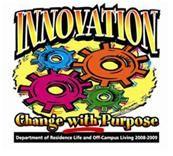
2008's theme, Innovation: Change with Purpose, reflected where we had been and where we seemed to be heading as a department at the beginning of the 2008 academic year. We acknowledged the sound foundation of our goals brought to life by the intentionality of our learning outcomes – a sense of purpose. We were eager to be the best we could be through re-evaluation and seeking new ideas – an openness to change. And we were energized by the concept of involving our entire team (all staff) and students in moving our department forward – a commitment to innovation. The logo reflects innovative concepts, and is based upon Andreas Rover's Looney Gears. The mechanical gears are unique in size and may, at first glance, appear that they would not move interchangeably, but they do. The logo is vibrant in color and appears to have movement, even on paper. It is this same vibrancy and constant activity that is found in our department.
2007: INSPIRE
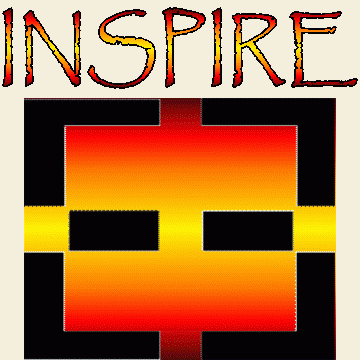
The logo above is an Adinkra symbol of support, inspiration, cooperation and encouragement. Metaphorically, it means that when you work for a good cause, you will get support. It also symbolizes aspiration, hope, mutual benefits, sharing and noble deeds. "One who climbs a tree worth climbing gets the help deserved." The symbol was designed in Africa to express the Akan social thought which maintains that any good individual effort deserves to be supported by the community. When one climbs a good tree that has fruits on it, people around will give him a push, since they know they will enjoy the fruits of his labor. It is a notion that reinforces the importance of aspiring towards a worthy course. Thoughts about the symbol and our theme; INSPIRE:
- Climbing a tree takes you to a higher level increasing your horizon; INSPIRING staff will take them to higher goals and accomplishment.
- Climbing a tree needs persistence, determination and perseverance; INSPIRE others to try again even if they fail and motivate them to achieve their goal.
- Support others to climb, but they do the climbing; INSPIRE others but they need to have their own goal.
- It is climbing a good tree that deserves a push; not all actions are INSPIRING.
2006: PASSION
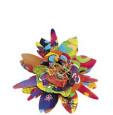
The theme for this academic year is PASSION. Represented by the Passion flower, PASSION hopes to celebrate the passion that we all have. This theme also incorporates a partnership with Passion Works in Athens. The Passion flower is used as the Passion Works logo and the Department of Residence Life is proud to have used it for our theme!
2005: ELEMENTS
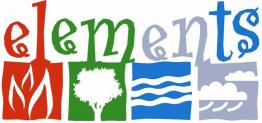
This year's theme, represented by the symbols for earth, air, fire and water, is ELEMENTS. It represents the re-focusing upon the basic constructs of the work we do, which will be occurring this year through our strategic planning process. Taking an in-depth look at the department from various perspectives will cause us to review the core of the department as well as the layers we've built upon our foundation. As we undergo this task, we must always remember the basic elemental efforts of residence halls on campus - to build relationships with students, help them be engaged and successful as students and help them grow as individuals.
2004: INTERSECTION

The theme represented in Chinese characters is INTERSECTION. The word intersection connotes the idea of a point where two or more things come together or meet. Each character taken separately has its own specific meaning. However, collectively the four characters mean INTERSECTION. The characters themselves are the intersection of various pen strokes combined in a particular way to form the word. There is not a randomness to these strokes rather an intentional intersection of the lines. Although to the untrained eye it may appear to be indecipherable, the deliberate intersection of the lines form this specific word. Perhaps the same can be said of your work in the halls and on the residential greens. The deliberate intersection of the department’s goals creates a whole greater than its parts and presents a powerful basis for our work. Often we see our work in the halls as separate and different from the learning that takes place in the classroom. But when we approach our work as the intersection of the out-of-classroom experience with the in-classroom learning we can create a richer and more meaningful educational experience for all of our residents.
2003: CONNECTIONS

In the early 1950's, scientists realized that nucleic acid, DNA, was the material stuff of the gene. This year marks the 50th anniversary of the discovery of DNA and the double helix. But the simple identification of DNA as the genetic material wasn't enough to advance further biological work. The missing connection was a detailed narrative of how that molecule was copied and how the cell reads its information. The answer to these questions could come only if a picture of the three-dimensional structure of DNA was produced. But what's the CONNECTION with our work? Education is about making connections and not about making copies. We want residents to become engaged in their learning and focus upon a particular subject matter is not enough. It is our role, as residence hall educators, to help individuals make connections between their classroom work and the larger world. Our challenge this year is not unlike the challenge those scientists faced in the 1950's, constructing a model that helps to make CONNECTIONS.
2002: IMAGINE

The theme was chosen to convey the idea that we need to "imagine" how the quality of life for residents can be enhanced through our work. If we want to be a truly inclusive community then we need to take the time to think through what we need to do to accomplish such a goal. We need to imagine what new ideas, insights, and knowledge are necessary to create such a place. Imagine a residential experience for all of our students based on the four goals of the department. If we use our ability to imagine such a place and collectively decided to work toward that end, we could create a fair and just community for all of our residents. Imagine such a place...
2001: MOSAIC

Question: How do you build a great residence life department? Answer: One staff person at a time. What truly brings a group of people together to accomplish great things is attention to the larger picture. Having a sense of the larger picture or what it is that we are collectively working toward is important. The same is true for a mosaic, our theme this year. For the mosaic to work, the artist has to have an overall picture or design in mind before making it. The department of residence life is not unlike a mosaic in that regard. We are made up of many different people in various roles. The four goals of the department: Human Development, Living/Learning, Tolerance and Community serve as our overall design. As we put together our mosaic, the design we have in mind is the four goals. They provide a sense of direction and purposefulness to our work.
2000: REFLECTIONS

Image, echo, duplication, mirror, imitate, mediation, rumination and retrospection. All of these words connote some meaning associated with our theme: Reflections. The word reflections conjures up the notion of an image being mirrored back as when we look into a mirror, a still pool of water, or perhaps a shiny object. Depending upon the smoothness of the surface, the image is either very clear or distorted. But regardless, it is still the same object. What is hampered is our ability to see it clearly. This notion of seeing clearly is imperative to our work in the residence halls. Orientation, in-services, supervisions and programs all afford opportunities for us to see our work more clearly. Our actions and behaviors reflect who we are. We should reflect to the past, ruminate about our work and allow this process to guide and direct our work into the future.
1999: LANDSCAPES
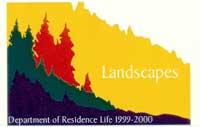
Landscapes was chosen to represent the variety of opportunities, challenges, and experiences in the world around us. This variety reveals itself on a number of levels (i.e. campus, local, state, national, world). As we approach the new millennium, there is much discussion about our future and purpose. It is in this vein that we are reminded of our responsibility as residence life staff. We have an obligation to help our residents navigate the lay of the land as well as to continually introduce them to new and broadening landscapes.
1998: PERSPECTIVES
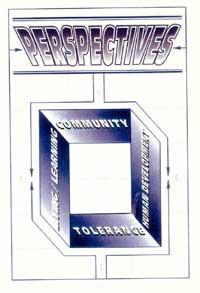
Often times what we do is look at things in relation to ourselves. This is only natural. The theme "Perspectives" conveys the necessity to look at things from different perspectives. The perspectives of people who are different, who come from different backgrounds, cultures, ethnicity, race, ability status and sexual orientation are important to our growth as individuals. We need to broaden our perspective. This is where the goals of the department can be quite helpful. For example, if we look at our lives through the lens of community it becomes readily apparent that we can't just look at what we need as an individual but that the needs of others must be considered. Gaining perspective helps to put the trivial in place and allow the essential to garner the attention it warrants. For a perspective to be meaningful and helpful it must be informed. Education and learning are certainly prerequisites to gaining an informed perspective. But experience is also an essential component. The more you can vary your perspective through life experiences over time, the deeper your understanding.
1997: JOURNEYS
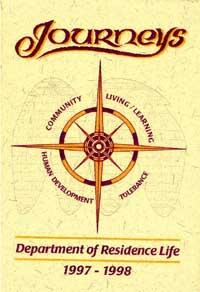
Probably what first comes to mind when one thinks about journeys is taking a trip or traveling. In keeping with this idea the department's theme, JOURNEYS, is an attempt to emphasize the idea of travel rather than destination. The intent is not to limit our thinking to just traveling a physical distance or going from one geographic point to another. Rather, think about journeys that we all have taken in our lives that are about personal growth and development. To be certain, these journeys have shaped and influenced our lives to date. But the idea of the theme is to get us to think about possibilities for the future, as well. We need to view these journeys as more than just getting from point A to point B. Rather we need to fully appreciate what we encounter on the way. There is an importance to being open to the numerous opportunities that reveal themselves along the way. Many times the unexpected part of our journey became the most important or significant occurrence.
1996: VOICES
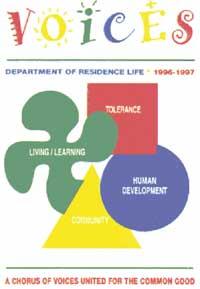
This theme was inspired by the writer Toni Morrison and her unique ability to give "voice" to important ideas and values through her writings. There's a direct connection between Morrison's stories and our work in residence life. The voices of different races, gender, sexual orientation, countries, cultures, experiences, individually tell little stories. On our campus, there are many voices vying for our attention, telling stories. The challenge centers around which voices will we hear and give credence? Decisions and judgments must be made. How do we know which voices to listen to? Which voices will inspire us? Move us? Compel us to act? What shall we give voice to? Through our work we should give voice to hope, compassion, justice, and forgiveness. Principles and values that reflect the department's goals are voices that should be heard. Voices that preach intolerance, hatred, and separation should be shunned.
1995: TRIBUTARIES
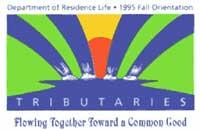
A tributary is usually associated with water and the logo used depicted four tributaries flowing together creating a lake or large river. This idea of flowing together to help create or contribute something greater was expressed through the theme. A small wooden boat was given as a gift to the staff in an effort to keep the notion of water in mind. Each tributary that flows toward this common end can be different and separate, yet it easily blends with the other three and creates something new and distinct. In other words, there is a way in which each of these separate tributaries contributes to the general creation of a larger lake or pool. It is not necessary for each tributary to give up its uniqueness but it is important for them to come together. Each of the staff members has something unique to contribute -- a gift to give. Our giving should be characterized by compassion, grace and civility. By successfully harnessing the course of such giving and directing toward a common good, we can contribute much to the life of the campus.
1994: JAZZ
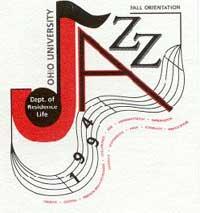
Symbolized by the logo incorporating a musical note and a staff with the words --creative, original, freedom within boundaries, collaborate, risk, experimentation, improvisation, diversity, spontaneous, fresh, flexibility and various styles. The theme of Jazz was to "convey the idea that individual contributions that may be spontaneous and even experimental at times can be part of achieving a common goal....When we work, there needs to be room for each of us to contribute our talents and knowledge toward the accomplishment of a common end. When jazz musicians play together they allow 'room' for each of the players to improvise and express themselves musically. But the individual players are always cognizant of the piece they are playing. Even as they improvise they don't lose sight of the fact that they are playing together. Our work will endure as long as we continue to contribute individually to the accomplishment of a common good."
1993: ANIWNA
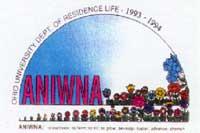
A Hopi Indian word, meaning "to cultivate," was symbolized by the gift of mixed flower seeds. The seeds given to the professional staff were later planted in memory of a deceased colleague. "The word, cultivate, has different meanings and uses. Our focus is on the use of this word as it relates to growing...This is what we want to convey with our theme Aniwna: to combine commitment, delight and dedication with intelligence, passion and labor. All of these ingredients are necessary for successfully growing a garden of flowers....While attending to the different needs of our students, we must keep in mind the common ground that we all share and need to cultivate."
1992: TAPESTRY
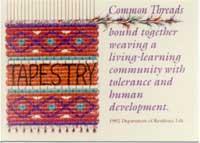
Tapestry was symbolized by a gift of a screen-printed woven tapestry of four colors of thread hung on small dowel rods. "Tapestry is a visual reference of what we want to create. A tapestry is often a careful weaving together of a variety of threads into a particular design or pattern. If it is done well, the individual threads that are used in the making become almost invisible and the overall pattern is what catches the viewer's eye. The threads that are used in a tapestry serve a dual purpose. They are woven together to create a tapestry while at the same time, they bind all of us together in this creative undertaking....Our challenge this year is to commit ourselves to the creation of a tapestry that affirms the dignity and respect of all on campus."
1991: VISION
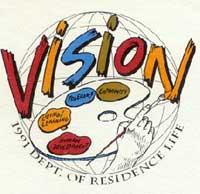
This theme was symbolized by a gift of a wooden artist's palette and paint brush. On the palette were four different colors of paint representing the four goals. The word 'vision' connotes the idea of a mental image or picture in one's mind. Staff develop a view of life in the halls that embraces the goals and values. By incorporating the goals of our department into each vision of life in the residence halls, we ensure the durability and persistence of that view.
1990: BRIDGES
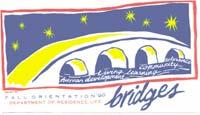
This theme was symbolized by the gift of a small wooden bridge with four arches carved by a local woods crafts-person. The concept was that "regardless of what construction or materials, all bridges serve a particular purpose or perform a specific function. Bridges do more than just provide pathways for people and vehicles. They span the barriers that divide, and they bring peoples, communities, and cultures close together. The goals of the department are the foundation for building solid bridges.
1989: HARMONY
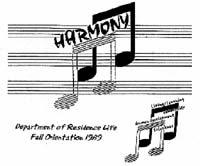
Harmony was chosen to " help convey the message of working together" or 'in concert' with one another....Orientation is a time of opportunity for creating a sense of harmony between the goals and our roles as staff members." This theme was symbolized by the gift of a kazoo presented to all staff members.
1988: FOCUS

This theme was specifically chosen to follow Foundations. Given the newness of our goals, it was necessary for the department to focus on the meaning and depth of the goals in our work. To move from laying a solid base, we had to challenge ourselves to become introspective so we could apply the goals to everyday interactions, tasks and behaviors. This theme was symbolized by a small glass prism. A prism takes in one beam of light but produces a spectrum of colors. We work with a goal in mind, but our efforts will produce a myriad of responses.
1987: FOUNDATIONS
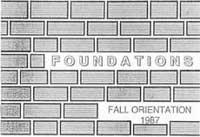
This theme was chosen, "to help convey the importance of having a firm, solid base in place before any building can take place. The four goals represent the foundation upon which we want to build....The knowledge, skills, attitudes, and behaviors that are shaped during the Orientation period will become the foundation for what we can even attempt to do over the next ten months." This theme was symbolized by the gift of four small bricks, representing the four departmental goals and for the beginnings of the Residence Life Foundation.
